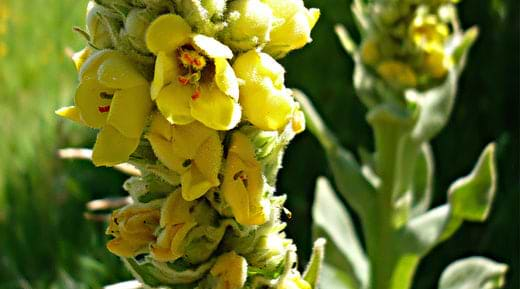
The Many Uses of Mullein and Its Hidden Potential
Written by Rebecca Younger, CH, CDShare
Imagine stumbling upon a fuzzy-leaved plant gracing your garden, offering a treasure trove of health benefits. That’s mullein for you, a plant that often appears as a wild volunteer, bringing a multitude of uses for herbal enthusiasts, gardeners, and health-conscious individuals. Mullein is also known for its microbial balancing and immune boosting properties, being effective against common bugs and unwanted invaders.
Known for its soft texture, mullein is derived from the Latin word “mollis,” meaning soft. Mullein belongs to the snapdragon family (Scrophulariaceae) and is scientifically known as Verbascum thapsus. While it’s just one of over 300 species within the Verbascum genus, it is the most common variety found. Mullein is a biennial plant, establishing roots and leaves in its first year of growth. In its second year, it blossoms with vibrant yellow flowers, leaving seeds to continue its legacy. Verbascum species play a significant role in Spanish folk medicine, traditionally used for treating various health conditions, including inflamed tissue states and digestion upset.
Interestingly, mullein isn't typically cultivated in herbal gardens. Instead, it grows in a serendipitous way, surprising gardeners with its presence. This characteristic makes it a lucky find for those who appreciate its medicinal properties and natural beauty.
An Herb with a History
Mullein’s historical significance is rooted in its versatile applications. Dating back to Roman times, its dried stalks were used as torches, earning it the nickname “candlewick plant.” Beyond its utility, the mullein plant has a storied past in traditional medicine, where it was employed to soothe respiratory ailments and promote overall well-being. Additionally, herbal medicines like mullein have demonstrated benefits and have been used historically for their medicinal properties.
Mullein (Verbascum Thapsus) is a medicinal plant that has been cherished for centuries in the realm of herbal medicine. This member of the snapdragon family is native to Europe, Asia, and North Africa, and is commonly known as common mullein. The plant’s leaves, flowers, and roots are utilized to create mullein extracts, teas, and other various herbal products and supplements. Revered for its versatility, mullein has earned its place in the pantheon of medicinal plants, offering a natural remedy for a variety of health conditions.
The Many Uses of Mullein
Mullein’s versatility extends far beyond its historical uses and botanical appeal. Whether it’s providing relief for common ailments, creating natural remedies, or enhancing gardens with its striking presence, mullein remains a valuable resource for numerous needs. However, when considering mullein in the form of dietary or herbal supplements alone, it is crucial to be aware of the varying quality, purity, and potency standards. Always consult healthcare professionals for guidance on trusted brands.
Respiratory Support
Mullein leaf has long been cherished for its benefits in improving lung health and alleviating symptoms associated with various respiratory discomforts. Renowned for soothing sore throats and coughs, and soothing symptoms of the common cold, the herb’s mucilage and saponins work together to calm irritated mucous membranes, making it a go-to remedy for respiratory discomfort. Here are some key benefits:
- Calms sore throats
- Soothes coughs
- Calms cold symptoms
In addition to its respiratory advantages, mullein tea is also believed to support overall immune health, offering a natural boost during the cold season.
Skin and Wound Care
Another remarkable use of mullein is in skin and wound care, where the lost art of herbal poultices finds renewal through its comforting properties. A mashed poultice of the leaf or a concentrated tea compress can be applied to the skin to support wound healing, soothe bruises, and ease irritations. It's essential to note that the fresh plant's hairs may irritate sensitive skin, but making tea or mashing the leaves can mitigate this issue.
Here are some key benefits:
- Supports minor wound healing
- Eases bruises and skin irritations
- Soothes redness
Mullein's versatility in natural healing practices makes it a valuable addition to any herbal remedy collection. Embracing its benefits can lead to healthier, skin conditions and quicker recovery.
Digestive Comfort
Mullein's mildly bitter flavor hints at its benefits for digestive health. Traditionally, mullein tea has been used to address digestive discomforts, making it a versatile addition to your herbal repertoire. Its natural properties provide relief and promote digestive well-being.
Incorporating Mullein tea into your routine can enhance your digestive health naturally and allow you to enjoy a healthier digestive system.
Mullein's Inflammatory Soothing Properties
Mullein is celebrated for its potent inflammatory soothing properties, making it a popular choice for treating respiratory discomforts and seasonal allergies. This is primarily due to its rich content of flavonoids, saponins, and other bioactive compounds. These natural constituents work synergistically to soothe inflammation and alleviate symptoms associated with respiratory discomfort. Additionally, mullein’s soothing effect on mucous membranes makes it an effective remedy for coughs, colds, and sore throats, providing much-needed relief when mucus and congestion lingers in the lungs.
Microbial Balancing Properties of Mullein
Mullein is a respiratory rock star, cherished for its knack for keeping your lungs happy and healthy. This ancient herb has a long history of being a go-to for soothing coughs and clearing congestion, but did you know it’s also got some serious chops when it comes to supporting your body’s natural defenses? Studies suggest that mullein may help maintain a healthy microbial balance in your body—lending its support against common challenges like occasional coughs, sinus woes, and seasonal sniffles.
Mullein’s natural properties make it an herbal ally worth adding to your wellness lineup. Keep in mind, though, if you have questions about your specific health needs, always chat with a trusted healthcare professional before starting something new.
Free Radical Scavenging Properties of Mullein
Rich in free radical scavengers, mullein offers a protective shield against free radicals and oxidative stress. These plant compounds play a crucial role in calming the inflammatory response and supporting lung health. Beyond respiratory health, mullein’s properties contribute to overall well-being by protecting the body against cell damage. Embracing mullein as part of your health regimen can provide a natural defense against the harmful effects of oxidative stress.
Synergistic Herb Combinations with Mullein
Mullein pairs well with other herbs to create a balanced approach to wellness. Here are some combinations to consider:
- Elderberry: Works with mullein for enhanced respiratory and immune support.
- Thyme: Adds further inflammatory soothing and respiratory benefits.
- Ginger: Complements mullein’s soothing effects with warming properties.
Combining mullein with these herbs creates a potent, synergistic blend for comprehensive health support.
How to Use Mullein
There are multiple ways to integrate mullein into your wellness routine:
- Teas: Brew dried mullein leaves or flowers for a soothing tea.
- Tinctures or Drops: Mullein tinctures are easy to take and absorb quickly.
- Poultices and Compresses: Mullein poultices are great for topical applications to soothe skin and ease bruising.
Suggested Use: Follow product-specific dosing recommendations or seek guidance from an herbalist to find the best approach for you.
WishGarden Products Featuring Mullein

Mullein’s gentle, herbal power has earned a well-deserved spot in several of our formulas designed to support healthy lungs and easy breathing. Whether you’re tackling seasonal sniffles, environmental challenges, or just showing your respiratory system some extra love, these mullein-infused remedies have your back (and your breath!).
- Deep Lung and Bronchial Support: A robust blend featuring mullein, designed to support healthy lungs and help maintain clear, deep breathing. Perfect for when you need your respiratory system to stay strong and resilient.
- Respiratory Strength Daily Support: A fast-acting formula combining mullein with other herbal powerhouses to promote easy breathing and support your lungs during seasonal or environmental stressors.
- Serious Cough Soothes & Quiets: Sometimes, your cough needs a little extra TLC. This formula taps into mullein’s soothing properties to help calm and support a healthy respiratory response when you’re feeling under the weather.
- Serious PM Cough Soothing Syrup: Sleep is a must for recovery, but a nagging cough can make it feel impossible. This bedtime formula featuring mullein works gently to promote restful sleep and keep your respiratory system calm through the night.
- Ear Be Well for Kids + Mullein Flower Ear Oil Kit: Mullein isn’t just a respiratory superstar; it’s also a key player in this formula crafted to support ear comfort and balance. It’s the perfect sidekick for when your ears feel a little “off.”
- Congestion Rescue Immune Support for Pregnancy: Created with moms-to-be in mind, this mullein-infused formula provides safe, effective support for relieving congestion and promoting comfortable breathing during pregnancy.
These remedies showcase mullein’s versatility as a respiratory superstar and a soothing ally for ear health, helping you breathe freely, rest well, and feel your best—all day, every day
The Power of Liquid Herbal Extracts
Why choose liquid herbal extracts over other forms? These concentrated tinctures offer several advantages that make them a superior choice for herbal supplementation:
- Fast-Acting Benefits: Liquid extracts bypass the digestive process required for breaking down pills or capsules, allowing for quick absorption directly into your bloodstream.
- Superior Absorption: Your body can absorb liquid herbs more efficiently than solid forms, making more of the beneficial compounds available for use.
- Easy to Customize: Liquid extracts are simple to adjust for your needs.
- Long Shelf Life: When properly stored, liquid herbal extracts maintain their potency for extended periods.
The Future of Mullein in Herbalism
The resurgence of interest in mullein reflects the value of preserving traditional, herbal medicine practices. Today’s herbalists continue to explore mullein’s potential, recognizing its multifaceted uses in modern wellness. As research advances, we may uncover even more applications, making mullein an essential part of holistic health for years to come.
Herbalist Q&A: Mullein
Q: How did Native Americans use mullein?
Native American tribes prized mullein for its versatility and effectiveness. Traditionally, they used mullein leaves and flowers to soothe coughs, support lung health, and calm inflamed tissues. Some tribes even smoked dried out mullein flowers and leaves to help with respiratory issues. Beyond the lungs, they found many uses for the plant’s soft leaves, from wound dressings to poultices. Mullein was, and still is, a trusted plant in traditional medicine.
Q: Does mullein have side effects?
Mullein is generally considered safe, but as with any herb, moderation is key. Some people may experience mild digestive upset, especially if they take too much. Allergic reactions are rare but possible, so if you’re new to mullein, start with a small amount to gauge your body’s response. Always consult a healthcare provider if you're pregnant, nursing, or on medications.
Q: How often should you take mullein?
For general respiratory support, mullein drops can be taken 2-3 times daily, though it's always best to follow the recommendations on the product label. Some people like to use it seasonally, while others keep it as a staple for times when they need extra lung support. As always, listen to your body and take breaks when using it long-term.
Q: What is the most effective way to take mullein?
The most effective way to take mullein depends on your needs. Mullein tinctures are popular for their convenience and fast absorption. For a soothing approach, mullein tea is fantastic for sipping, especially when you’re feeling under the weather. Steaming with mullein leaves is another effective method, particularly if you’re dealing with congestion. Try different methods to find what works best for you!
Rebecca Younger is passionate about herbs and women's health. She aspires to plant seeds of inspiration within her community about plant medicine and healthier ways of life. She studied Herbal Medicine at Herbalism Roots in Denver and is a certified Doula through the Matrona Foundation. She is the Brand Communications Specialist at WishGarden Herbs.
For educational purposes only. This information has not been evaluated by the Food and Drug Administration. This information is not intended to diagnose, treat, cure, or prevent any disease, or to sell any product.




















